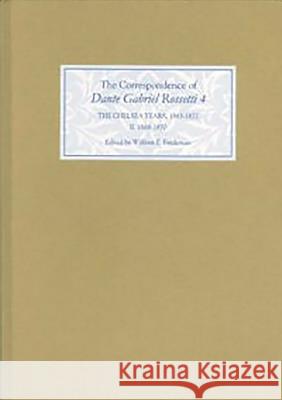The Correspondence of Dante Gabriel Rossetti 4: The Chelsea Years, 1863-1872: Prelude to Crisis II. 1868-1870 » książka
The Correspondence of Dante Gabriel Rossetti 4: The Chelsea Years, 1863-1872: Prelude to Crisis II. 1868-1870
ISBN-13: 9780859917940 / Angielski / Twarda / 2004 / 608 str.
The Correspondence of Dante Gabriel Rossetti 4: The Chelsea Years, 1863-1872: Prelude to Crisis II. 1868-1870
ISBN-13: 9780859917940 / Angielski / Twarda / 2004 / 608 str.
(netto: 627,14 VAT: 5%)
Najniższa cena z 30 dni: 651,77
ok. 30 dni roboczych
Bez gwarancji dostawy przed świętami
Darmowa dostawa!
Following the death of Elizabeth Siddal in 1862 and his settling in Chelsea, Rossetti entered on a period of his life -- charted in volume 3 -- that was marked by renewed activity as a painter and increased financial prosperity. The years 1868-1870 covered by volume 4 culminate in his return to writing poetry and the publication in June 1870 of his long-anticipated and widely-read Poems. However, despite the satisfaction that he could take from his standing as a painter and from the fact that he was about to establish himself as a poet, 1868-1870 were troubled years for Rossetti. Problems with his eyesight led him to give up painting for long periods, and to fear that, like his father before him, he would end his days blind. He consulted Sir William Bowman and other leading ophthalmologists, who eased his mind sufficiently for him to return to his easel. This was also the time when he declared his love for Jane Morris, the wife of his long-time friend and admirer William Morris. In his long, moving letters to Janey we come face to face with the satisfactions and frustrations of their relationship. The letters to Janey provide a context for understanding the many paintings and drawings from this period for which she was the model, and for gauging the biographical origins of the sonnets, written at this time for the sequence, The House of Life, an early version of which was included in Poems.Probably the most rewarding letters in the volume concern the preparation of Poems. The letters deal at length with Rossetti's decision to have his poems typeset for distribution to friends, the exhumation of Elizabeth Siddal's coffin to recover the manuscript of his poems, his obsessive care over the physical appearance of the volume, especially the binding, and his efforts at -working the oracle, - William Bell Scott's description of his methodically lining up sympathetic reviewers.As with all of Rossetti's correspondence, the letters in volume 4 are replete with pointed and sometimes humorous commentary on an array of people and events, ranging from Edward Burne-Jones's affair with -the Greek damzel, - Mary Zambaco, and Frederick Sandys's appropriation of subjects from his pictures, to his unease over Swinburne's uncontrollable drunkenness, and his ominous hatred of Robert Buchanan, the author of the -Fleshly School- attack on his poetry in the Contemporary Review of October 1871, which became a major cause of the disastrous events of the years 1871-1872.











